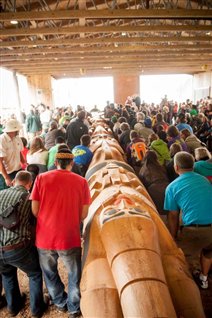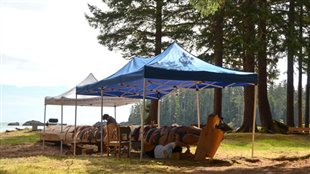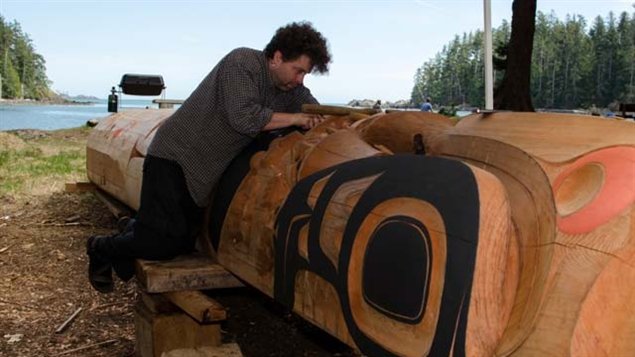
Lifting the totem from the carving
shed in Skidegate, to the barge taking it to Gwaii Hanaas
A 500-year-old giant red cedar is set to become part of Canadian history today. Aboriginal carvers have created a “legacy” totem to mark the 20th anniversary of an agreement between the federal government and the Haida which created the Gwaii Hanaas National Park Reserve and the Haida Heritage Site.
The 13-metre carved pole, with an additional 3 metres set into the ground to anchor it, will be the first totem erected in the region in 130 years.
It celebrates the Gwaii Hanaas Agreement which allows the federal government and the Haida to co-manage and protect the region.
The carving work began a year ago led by Jaalen Edenshaw, with help from his brother and his cousin in Skidegate on Graham Island, the largest island in the archipelago. Earlier this year, the mostly completed pole was moved by barge to Lyell Island where finishing touches have been carried out.
The site on Lyell Island is significant as the area in 1985 where dozens of the Haida Nation gathered to block a logging road and protest against logging old growth forests.
Dozens were arrested but two years later the area was declared a heritage site. The original conflict is represented on the pole with five people standing together holding hands.

(formerly Queen Charlotte Islands) © Google Maps
The 1993 agreement between the government and Haida is represented by a sculpin fish at the bottom of the pole, and an eagle at the top, to symbolize an area that is protected, “from ocean floor to mountain top” said Edenshaw.
A grizzly bear, dogs, a raven and three Haida Gwaii watchmen are also part of the pole.
It will be the first pole on Lyell Island, Other much older poles, now deteriorating are found on SGang Gwaay, or Anthony Island, on the southwest corner of Gwaii Haana

(Aug 15,2013) © J Shafto-Parks Canada
Peter Lantin, president of the Haida Nation, says while the pole celebrates the 1993 agreement, it also symbolizes the preservation of Haida culture. About a century ago, smallpox killed most of the Haida population on Gwaii Hanaas, including those with the knowledge of totem carving.
“It’s taken a long time for us to get back into the swing of it,” he said.
Jason Alsop, chief executive officer of the Haida Heritage Centre said he hopes more poles will be raised in the future.

Gwaay, or Anthony Island, on the southwest corner
of Gwaii Haanas. © CBC
About 200 people will be needed to pull on the several ropes to lift the pole into its position at Windy Bay.







For reasons beyond our control, and for an undetermined period of time, our comment section is now closed. However, our social networks remain open to your contributions.